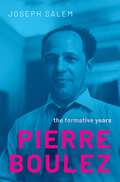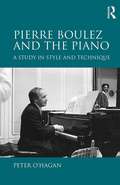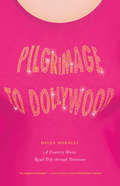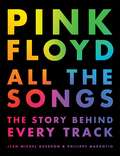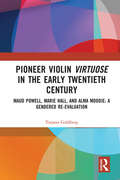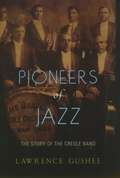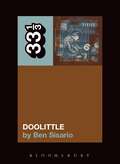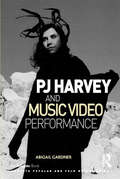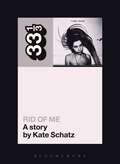- Table View
- List View
Pierre Boulez: The Formative Years
by Joseph SalemAs an integral figure in twentieth-century music, Pierre Boulez innovated new musical ideas through extraordinary creative processes. His formative years tracked his compositional development from his confrontations with serialism to drafting one of his major works, Pli selon pli, in the early 1960s. Part biography, part survey, Pierre Boulez: The Formative Years situates Boulez and his compositions among a complex network of influences. To best understand Boulez's creative process, author Joseph R. Salem organizes the book into three parts. First, Boulez's early life, training, and education provide biographical context for his career. Salem provides a fresh, revisionist perspective of the composer's life by drawing upon a mix of primary and secondary sources. Second, the brunt of the biography situates Boulez's musical works and experimentation among a host of contextual contexts. In place of scores and complicated musical analyses, Salem employs sketches as a visual metonym. The sketches denote Boulez's continual ability to self-reform, accept feedback from his peers, mentors, and family members, and revitalize old material. Third, Boulez's legacy is associated with contemporaneous aesthetic movements and artistic challenges. While his creative processes undoubtedly influenced music today, Boulez remains a controversial, even taboo, figure among contemporary musicians and audiences. A book that both celebrates and critiques its subject, The Formative Years urges a reconsideration of narratives and discussions surrounding Boulez's life and works.
Pierre Boulez and the Piano: A Study in Style and Technique
by Peter O'HaganPierre Boulez's first piano pieces date from his youth, prior to his studies in Paris with Messiaen, and his subsequent meteoric rise to international acclaim as the leader of the musical avant-garde during the 1950s. His most recent published work is a solo piano piece, Une page d’éphéméride, written some sixty years after his first attempts at composition. The piano has remained central to Boulez's creative work throughout his career, and although his renown as a conductor has to some extent overshadowed his other achievements, it was as a performer of his own piano music that his practical gifts first found expression. Peter O'Hagan has given performances of various unpublished piano works by Boulez, including Antiphonie from the Third Sonata and Trois Psalmodies. In this study, he considers Boulez's writing for the piano in the context of the composer's stylistic evolution throughout the course of his development. Each of the principal works is considered in detail, not only on its own terms, but also as a stage in Boulez's ongoing quest to invent radical solutions to the renewal of musical language and to reinvigorate tradition. The volume includes reference to hitherto unpublished source material, which sheds light on his working methods and on the interrelationship between works.
Pierre Boulez and the Piano: A Study in Style and Technique
by Peter O'HaganPierre Boulez's first piano pieces date from his youth, prior to his studies in Paris with Messiaen, and his subsequent meteoric rise to international acclaim as the leader of the musical avant-garde during the 1950s. His most recent published work is a solo piano piece, Une page d’éphéméride, written some sixty years after his first attempts at composition. The piano has remained central to Boulez's creative work throughout his career, and although his renown as a conductor has to some extent overshadowed his other achievements, it was as a performer of his own piano music that his practical gifts first found expression. Peter O'Hagan has given performances of various unpublished piano works by Boulez, including Antiphonie from the Third Sonata and Trois Psalmodies. In this study, he considers Boulez's writing for the piano in the context of the composer's stylistic evolution throughout the course of his development. Each of the principal works is considered in detail, not only on its own terms, but also as a stage in Boulez's ongoing quest to invent radical solutions to the renewal of musical language and to reinvigorate tradition. The volume includes reference to hitherto unpublished source material, which sheds light on his working methods and on the interrelationship between works.
Pietro Von Abano (Selected Works of Louis Spohr, 1784-1859)
by Clive BrownVolume 3 of the SELECTED WORKS OF Louis Spohr 1784-1859- Pietro von Abano. At about this time one of his pupils, the twenty-three-year-old Carl Friedrich Curschmann, who had ambitions to compose an opera, showed Spohr a libretto that had been adapted from Ludwig Tieck's novel Pietro von Abano oder Petrus Apone, eine Zaubergeschichte (Breslau 1825) by the Kassel lawyer and poet Carl Pfeiffer. Spohr was immediately impressed by the libretto and, having dissuaded Curschmann from going ahead with the project, probably on the grounds that he was too inexperienced for such a major undertaking, he came to an agreement with Curschmann and Pfeiffer that he should set it himself. Including the plot, script and screenshots of the original music documents.
Pietro Von Abano (Selected Works of Louis Spohr, 1784-1859 #3)
by Clive BrownVolume 3 of the SELECTED WORKS OF Louis Spohr 1784-1859- Pietro von Abano. At about this time one of his pupils, the twenty-three-year-old Carl Friedrich Curschmann, who had ambitions to compose an opera, showed Spohr a libretto that had been adapted from Ludwig Tieck's novel Pietro von Abano oder Petrus Apone, eine Zaubergeschichte (Breslau 1825) by the Kassel lawyer and poet Carl Pfeiffer. Spohr was immediately impressed by the libretto and, having dissuaded Curschmann from going ahead with the project, probably on the grounds that he was too inexperienced for such a major undertaking, he came to an agreement with Curschmann and Pfeiffer that he should set it himself. Including the plot, script and screenshots of the original music documents.
Pilgrimage to Dollywood: A Country Music Road Trip through Tennessee (Culture Trails: Adventures in Travel)
by Helen MoralesA star par excellence, Dolly Parton is one of country music’s most likable personalities. Even a hard-rocking punk or orchestral aesthete can’t help cracking a smile or singing along with songs like “Jolene” and “9 to 5.” More than a mere singer or actress, Parton is a true cultural phenomenon, immediately recognizable and beloved for her talent, tinkling laugh, and steel magnolia spirit. She is also the only female star to have her own themed amusement park: Dollywood in Pigeon Forge, Tennessee. Every year thousands of fans flock to Dollywood to celebrate the icon, and Helen Morales is one of those fans. In Pilgrimage to Dollywood, Morales sets out to discover Parton’s Tennessee. Her travels begin at the top celebrity pilgrimage site of Elvis Presley’s Graceland, then take her to Loretta Lynn’s ranch in Hurricane Mills; the Country Music Hall of Fame and the Grand Ole Opry in Nashville; to Sevierville, Gatlinburg, and the Great Smoky Mountains National Park; and finally to Pigeon Forge, home of the “Dolly Homecoming Parade,” featuring the star herself as grand marshall. Morales’s adventure allows her to compare the imaginary Tennessee of Parton’s lyrics with the real Tennessee where the singer grew up, looking at essential connections between country music, the land, and a way of life. It’s also a personal pilgrimage for Morales. Accompanied by her partner, Tony, and their nine-year-old daughter, Athena (who respectively prefer Mozart and Miley Cyrus), Morales, a recent transplant from England, seeks to understand America and American values through the celebrity sites and attractions of Tennessee. This celebration of Dolly and Americana is for anyone with an old country soul who relies on music to help understand the world, and it is guaranteed to make a Dolly Parton fan of anyone who has not yet fallen for her music or charisma.
Pilgrimage to Dollywood: A Country Music Road Trip through Tennessee (Culture Trails: Adventures in Travel)
by Helen MoralesA star par excellence, Dolly Parton is one of country music’s most likable personalities. Even a hard-rocking punk or orchestral aesthete can’t help cracking a smile or singing along with songs like “Jolene” and “9 to 5.” More than a mere singer or actress, Parton is a true cultural phenomenon, immediately recognizable and beloved for her talent, tinkling laugh, and steel magnolia spirit. She is also the only female star to have her own themed amusement park: Dollywood in Pigeon Forge, Tennessee. Every year thousands of fans flock to Dollywood to celebrate the icon, and Helen Morales is one of those fans. In Pilgrimage to Dollywood, Morales sets out to discover Parton’s Tennessee. Her travels begin at the top celebrity pilgrimage site of Elvis Presley’s Graceland, then take her to Loretta Lynn’s ranch in Hurricane Mills; the Country Music Hall of Fame and the Grand Ole Opry in Nashville; to Sevierville, Gatlinburg, and the Great Smoky Mountains National Park; and finally to Pigeon Forge, home of the “Dolly Homecoming Parade,” featuring the star herself as grand marshall. Morales’s adventure allows her to compare the imaginary Tennessee of Parton’s lyrics with the real Tennessee where the singer grew up, looking at essential connections between country music, the land, and a way of life. It’s also a personal pilgrimage for Morales. Accompanied by her partner, Tony, and their nine-year-old daughter, Athena (who respectively prefer Mozart and Miley Cyrus), Morales, a recent transplant from England, seeks to understand America and American values through the celebrity sites and attractions of Tennessee. This celebration of Dolly and Americana is for anyone with an old country soul who relies on music to help understand the world, and it is guaranteed to make a Dolly Parton fan of anyone who has not yet fallen for her music or charisma.
Pilgrimage to Dollywood: A Country Music Road Trip through Tennessee (Culture Trails: Adventures in Travel)
by Helen MoralesA star par excellence, Dolly Parton is one of country music’s most likable personalities. Even a hard-rocking punk or orchestral aesthete can’t help cracking a smile or singing along with songs like “Jolene” and “9 to 5.” More than a mere singer or actress, Parton is a true cultural phenomenon, immediately recognizable and beloved for her talent, tinkling laugh, and steel magnolia spirit. She is also the only female star to have her own themed amusement park: Dollywood in Pigeon Forge, Tennessee. Every year thousands of fans flock to Dollywood to celebrate the icon, and Helen Morales is one of those fans. In Pilgrimage to Dollywood, Morales sets out to discover Parton’s Tennessee. Her travels begin at the top celebrity pilgrimage site of Elvis Presley’s Graceland, then take her to Loretta Lynn’s ranch in Hurricane Mills; the Country Music Hall of Fame and the Grand Ole Opry in Nashville; to Sevierville, Gatlinburg, and the Great Smoky Mountains National Park; and finally to Pigeon Forge, home of the “Dolly Homecoming Parade,” featuring the star herself as grand marshall. Morales’s adventure allows her to compare the imaginary Tennessee of Parton’s lyrics with the real Tennessee where the singer grew up, looking at essential connections between country music, the land, and a way of life. It’s also a personal pilgrimage for Morales. Accompanied by her partner, Tony, and their nine-year-old daughter, Athena (who respectively prefer Mozart and Miley Cyrus), Morales, a recent transplant from England, seeks to understand America and American values through the celebrity sites and attractions of Tennessee. This celebration of Dolly and Americana is for anyone with an old country soul who relies on music to help understand the world, and it is guaranteed to make a Dolly Parton fan of anyone who has not yet fallen for her music or charisma.
Pilgrimage to Dollywood: A Country Music Road Trip through Tennessee (Culture Trails: Adventures in Travel)
by Helen MoralesA star par excellence, Dolly Parton is one of country music’s most likable personalities. Even a hard-rocking punk or orchestral aesthete can’t help cracking a smile or singing along with songs like “Jolene” and “9 to 5.” More than a mere singer or actress, Parton is a true cultural phenomenon, immediately recognizable and beloved for her talent, tinkling laugh, and steel magnolia spirit. She is also the only female star to have her own themed amusement park: Dollywood in Pigeon Forge, Tennessee. Every year thousands of fans flock to Dollywood to celebrate the icon, and Helen Morales is one of those fans. In Pilgrimage to Dollywood, Morales sets out to discover Parton’s Tennessee. Her travels begin at the top celebrity pilgrimage site of Elvis Presley’s Graceland, then take her to Loretta Lynn’s ranch in Hurricane Mills; the Country Music Hall of Fame and the Grand Ole Opry in Nashville; to Sevierville, Gatlinburg, and the Great Smoky Mountains National Park; and finally to Pigeon Forge, home of the “Dolly Homecoming Parade,” featuring the star herself as grand marshall. Morales’s adventure allows her to compare the imaginary Tennessee of Parton’s lyrics with the real Tennessee where the singer grew up, looking at essential connections between country music, the land, and a way of life. It’s also a personal pilgrimage for Morales. Accompanied by her partner, Tony, and their nine-year-old daughter, Athena (who respectively prefer Mozart and Miley Cyrus), Morales, a recent transplant from England, seeks to understand America and American values through the celebrity sites and attractions of Tennessee. This celebration of Dolly and Americana is for anyone with an old country soul who relies on music to help understand the world, and it is guaranteed to make a Dolly Parton fan of anyone who has not yet fallen for her music or charisma.
Pilgrimage to Dollywood: A Country Music Road Trip through Tennessee (Culture Trails: Adventures in Travel)
by Helen MoralesA star par excellence, Dolly Parton is one of country music’s most likable personalities. Even a hard-rocking punk or orchestral aesthete can’t help cracking a smile or singing along with songs like “Jolene” and “9 to 5.” More than a mere singer or actress, Parton is a true cultural phenomenon, immediately recognizable and beloved for her talent, tinkling laugh, and steel magnolia spirit. She is also the only female star to have her own themed amusement park: Dollywood in Pigeon Forge, Tennessee. Every year thousands of fans flock to Dollywood to celebrate the icon, and Helen Morales is one of those fans. In Pilgrimage to Dollywood, Morales sets out to discover Parton’s Tennessee. Her travels begin at the top celebrity pilgrimage site of Elvis Presley’s Graceland, then take her to Loretta Lynn’s ranch in Hurricane Mills; the Country Music Hall of Fame and the Grand Ole Opry in Nashville; to Sevierville, Gatlinburg, and the Great Smoky Mountains National Park; and finally to Pigeon Forge, home of the “Dolly Homecoming Parade,” featuring the star herself as grand marshall. Morales’s adventure allows her to compare the imaginary Tennessee of Parton’s lyrics with the real Tennessee where the singer grew up, looking at essential connections between country music, the land, and a way of life. It’s also a personal pilgrimage for Morales. Accompanied by her partner, Tony, and their nine-year-old daughter, Athena (who respectively prefer Mozart and Miley Cyrus), Morales, a recent transplant from England, seeks to understand America and American values through the celebrity sites and attractions of Tennessee. This celebration of Dolly and Americana is for anyone with an old country soul who relies on music to help understand the world, and it is guaranteed to make a Dolly Parton fan of anyone who has not yet fallen for her music or charisma.
Pilgrimage to Dollywood: A Country Music Road Trip through Tennessee (Culture Trails: Adventures in Travel)
by Helen MoralesA star par excellence, Dolly Parton is one of country music’s most likable personalities. Even a hard-rocking punk or orchestral aesthete can’t help cracking a smile or singing along with songs like “Jolene” and “9 to 5.” More than a mere singer or actress, Parton is a true cultural phenomenon, immediately recognizable and beloved for her talent, tinkling laugh, and steel magnolia spirit. She is also the only female star to have her own themed amusement park: Dollywood in Pigeon Forge, Tennessee. Every year thousands of fans flock to Dollywood to celebrate the icon, and Helen Morales is one of those fans. In Pilgrimage to Dollywood, Morales sets out to discover Parton’s Tennessee. Her travels begin at the top celebrity pilgrimage site of Elvis Presley’s Graceland, then take her to Loretta Lynn’s ranch in Hurricane Mills; the Country Music Hall of Fame and the Grand Ole Opry in Nashville; to Sevierville, Gatlinburg, and the Great Smoky Mountains National Park; and finally to Pigeon Forge, home of the “Dolly Homecoming Parade,” featuring the star herself as grand marshall. Morales’s adventure allows her to compare the imaginary Tennessee of Parton’s lyrics with the real Tennessee where the singer grew up, looking at essential connections between country music, the land, and a way of life. It’s also a personal pilgrimage for Morales. Accompanied by her partner, Tony, and their nine-year-old daughter, Athena (who respectively prefer Mozart and Miley Cyrus), Morales, a recent transplant from England, seeks to understand America and American values through the celebrity sites and attractions of Tennessee. This celebration of Dolly and Americana is for anyone with an old country soul who relies on music to help understand the world, and it is guaranteed to make a Dolly Parton fan of anyone who has not yet fallen for her music or charisma.
Pilgrimage to Dollywood: A Country Music Road Trip through Tennessee (Culture Trails: Adventures in Travel)
by Helen MoralesA star par excellence, Dolly Parton is one of country music’s most likable personalities. Even a hard-rocking punk or orchestral aesthete can’t help cracking a smile or singing along with songs like “Jolene” and “9 to 5.” More than a mere singer or actress, Parton is a true cultural phenomenon, immediately recognizable and beloved for her talent, tinkling laugh, and steel magnolia spirit. She is also the only female star to have her own themed amusement park: Dollywood in Pigeon Forge, Tennessee. Every year thousands of fans flock to Dollywood to celebrate the icon, and Helen Morales is one of those fans. In Pilgrimage to Dollywood, Morales sets out to discover Parton’s Tennessee. Her travels begin at the top celebrity pilgrimage site of Elvis Presley’s Graceland, then take her to Loretta Lynn’s ranch in Hurricane Mills; the Country Music Hall of Fame and the Grand Ole Opry in Nashville; to Sevierville, Gatlinburg, and the Great Smoky Mountains National Park; and finally to Pigeon Forge, home of the “Dolly Homecoming Parade,” featuring the star herself as grand marshall. Morales’s adventure allows her to compare the imaginary Tennessee of Parton’s lyrics with the real Tennessee where the singer grew up, looking at essential connections between country music, the land, and a way of life. It’s also a personal pilgrimage for Morales. Accompanied by her partner, Tony, and their nine-year-old daughter, Athena (who respectively prefer Mozart and Miley Cyrus), Morales, a recent transplant from England, seeks to understand America and American values through the celebrity sites and attractions of Tennessee. This celebration of Dolly and Americana is for anyone with an old country soul who relies on music to help understand the world, and it is guaranteed to make a Dolly Parton fan of anyone who has not yet fallen for her music or charisma.
Pink Floyd All the Songs: The Story Behind Every Track (All The Songs)
by Jean-Michel Guesdon Philippe MargotinThe newest addition to the best-selling All the Songs series details the unique recording history of Pink Floyd, one of the world's most commercially successful and influential rock bands.Since 1965, Pink Floyd been recording sonically experimental and philosophical music, selling more than 250 million records worldwide, including two of the best-selling albums of all time Dark Side of the Moon and The Wall. While much is known about this iconic group, few books provide a comprehensive history of their time in the studio. In Pink Floyd All the Songs, authors Margotin and Guesdon describe the origin of their nearly 200 released songs, details from the recording studio, what instruments were used, and behind-the-scenes stories of the tensions that helped drive the band.Organized chronologically by album, this massive, 544-page hardcover begins with their 1967 debut album The Piper at the Gates of Dawn, the only one recorded under founding member Syd Barrett's leadership; through the loss of Barrett and the addition of David Gilmour; to Richard Wright leaving the band in 1979 but returning; to Roger Waters leaving in 1985 and the albums recorded since his departure, including their 2014 farewell album, The Endless River, which was downloaded 12 million times on Spotify the week it was released. Packed with more than 500 photos, All the Songs is also filled with stories fans treasure, such as Waters working with engineer Alan Parsons to employ revolutionary recording techniques for The Dark Side of the Moon at Abbey Road Studios in 1972 or producer Bob's Ezrin's contribution in refining Water's original sprawling vision for The Wall.
Pink Floyd All the Songs: The Story Behind Every Track (All the Songs)
by Jean-Michel Guesdon Philippe MargotinThe newest addition to the best-selling All the Songs series details the unique recording history of Pink Floyd, one of the world's most commercially successful and influential rock bands. Since 1965, Pink Floyd been recording sonically experimental and philosophical music, selling more than 250 million records worldwide, including two of the best-selling albums of all time Dark Side of the Moon and The Wall. While much is known about this iconic group, few books provide a comprehensive history of their time in the studio. In Pink Floyd All the Songs, authors Margotin and Guesdon describe the origin of their nearly 200 released songs, details from the recording studio, what instruments were used, and behind-the-scenes stories of the tensions that helped drive the band. Organized chronologically by album, this massive, 544-page hardcover begins with their 1967 debut album The Piper at the Gates of Dawn, the only one recorded under founding member Syd Barrett's leadership; through the loss of Barrett and the addition of David Gilmour; to Richard Wright leaving the band in 1979 but returning; to Roger Waters leaving in 1985 and the albums recorded since his departure, including their 2014 farewell album, The Endless River, which was downloaded 12 million times on Spotify the week it was released. Packed with more than 500 photos, All the Songs is also filled with stories fans treasure, such as Waters working with engineer Alan Parsons to employ revolutionary recording techniques for The Dark Side of the Moon at Abbey Road Studios in 1972 or producer Bob's Ezrin's contribution in refining Water's original sprawling vision for The Wall.
Pioneer Violin Virtuose in the Early Twentieth Century: Maud Powell, Marie Hall, and Alma Moodie: A Gendered Re-Evaluation
by Tatjana GoldbergTatjana Goldberg reveals the extent to which gender and socially constructed identity influenced female violinists’ ‘separate but unequal’ status in a great male-dominated virtuoso lineage by focussing on the few that stood out: the American Maud Powell (1867–1920), Australian-born Alma Moodie (1898–1943), and the British Marie Hall (1884–1956). Despite breaking down traditional gender-based patriarchal social and cultural norms, becoming celebrated soloists, and greatly contributing towards violin works and the early recording industry (Powell and Hall), they received little historical recognition. Goldberg provides a more complete picture of their artistic achievements and the impact they had on audiences.
Pioneer Violin Virtuose in the Early Twentieth Century: Maud Powell, Marie Hall, and Alma Moodie: A Gendered Re-Evaluation
by Tatjana GoldbergTatjana Goldberg reveals the extent to which gender and socially constructed identity influenced female violinists’ ‘separate but unequal’ status in a great male-dominated virtuoso lineage by focussing on the few that stood out: the American Maud Powell (1867–1920), Australian-born Alma Moodie (1898–1943), and the British Marie Hall (1884–1956). Despite breaking down traditional gender-based patriarchal social and cultural norms, becoming celebrated soloists, and greatly contributing towards violin works and the early recording industry (Powell and Hall), they received little historical recognition. Goldberg provides a more complete picture of their artistic achievements and the impact they had on audiences.
Pioneers of Jazz: The Story of the Creole Band
by Lawrence GusheeThanks to the pioneering tours of the Creole Band, jazz began to be heard nationwide on the vaudeville stages of America from 1914 to 1918. This seven-piece band toured the country, exporting for the first time the authentic jazz strains that had developed in New Orleans at the start of the 20th century. The band's vaudeville routines were deeply rooted in the minstrel shows and plantation cliches of American show business in the late 19th century, but its instrumental music was central to its performance and distinctive and entrancing to audiences and reviewers. Pioneers of Jazz reveals at long last the link between New Orleans music and the jazz phenomenon that swept America in the 1920s. While they were the first important band from New Orleans to attain national exposure, The Creole Band has not heretofore been recognized for its unique importance. But in his monumental, careful research, jazz scholar Lawrence Gushee firmly establishes the group's central role in jazz history. Gushee traces the troupe's activities and quotes the reaction of critics and audiences to their first encounters with this new musical phenomenon. While audiences often expected (and got) a kind of minstrel show, the group transcended expectations, taking pride in their music and facing down the theatrical establishment with courage. Although they played the West Coast and Canada, most of their touring centered in the heartland. Most towns of any size in Iowa, Illinois, and Indiana heard them, often repeatedly, and virtually all of their appearances were received with wild enthusiasm. After four years of nearly incessant traveling, members of the band founded or joined groups in Chicago's South Side cabaret scene, igniting the craze for hot New Orleans music for which the Windy City was renowned in the early 1920s. The best-known musicians in the group--cornetist Freddie Keppard, clarinetist Jimmy Noone and string bassist Bill Johnson--would play a significant role in jazz, becoming famous for recordings in the 1920s. Gushee effectively brings to life each member of the band and discusses their individual contributions, while analyzing the music with precision, skillful and exacting documentation. Including many never before published photos and interviews, the book also provides an invaluable and colorful look at show business, especially vaudeville, in the 1910s. While some of the first jazz historians were aware of the band's importance, attempts to locate and interview surviving members (three died before 1935) were sporadic and did little or nothing to correct the mostly erroneous accounts of the band's career. The jazz world has long known about Gushee's original work on this previously neglected subject, and the book represents an important event in jazz scholarship. Pioneers of Jazz brilliantly places this group's unique importance into a broad cultural and historical context, and provides the crucial link between jazz's origins in New Orleans and the beginning of its dissemination across the country.
Pioneers of Jazz: The Story of the Creole Band
by Lawrence GusheeThanks to the pioneering tours of the Creole Band, jazz began to be heard nationwide on the vaudeville stages of America from 1914 to 1918. This seven-piece band toured the country, exporting for the first time the authentic jazz strains that had developed in New Orleans at the start of the 20th century. The band's vaudeville routines were deeply rooted in the minstrel shows and plantation cliches of American show business in the late 19th century, but its instrumental music was central to its performance and distinctive and entrancing to audiences and reviewers. Pioneers of Jazz reveals at long last the link between New Orleans music and the jazz phenomenon that swept America in the 1920s. While they were the first important band from New Orleans to attain national exposure, The Creole Band has not heretofore been recognized for its unique importance. But in his monumental, careful research, jazz scholar Lawrence Gushee firmly establishes the group's central role in jazz history. Gushee traces the troupe's activities and quotes the reaction of critics and audiences to their first encounters with this new musical phenomenon. While audiences often expected (and got) a kind of minstrel show, the group transcended expectations, taking pride in their music and facing down the theatrical establishment with courage. Although they played the West Coast and Canada, most of their touring centered in the heartland. Most towns of any size in Iowa, Illinois, and Indiana heard them, often repeatedly, and virtually all of their appearances were received with wild enthusiasm. After four years of nearly incessant traveling, members of the band founded or joined groups in Chicago's South Side cabaret scene, igniting the craze for hot New Orleans music for which the Windy City was renowned in the early 1920s. The best-known musicians in the group--cornetist Freddie Keppard, clarinetist Jimmy Noone and string bassist Bill Johnson--would play a significant role in jazz, becoming famous for recordings in the 1920s. Gushee effectively brings to life each member of the band and discusses their individual contributions, while analyzing the music with precision, skillful and exacting documentation. Including many never before published photos and interviews, the book also provides an invaluable and colorful look at show business, especially vaudeville, in the 1910s. While some of the first jazz historians were aware of the band's importance, attempts to locate and interview surviving members (three died before 1935) were sporadic and did little or nothing to correct the mostly erroneous accounts of the band's career. The jazz world has long known about Gushee's original work on this previously neglected subject, and the book represents an important event in jazz scholarship. Pioneers of Jazz brilliantly places this group's unique importance into a broad cultural and historical context, and provides the crucial link between jazz's origins in New Orleans and the beginning of its dissemination across the country.
The Pipe Organ: A Composer's Guide
by James MitchellThe organ is one of the oldest instruments in Western music, and its sound has inspired many of the greatest composers from the past half a millennium from Bach through to Messiaen. The full possibilities of the instrument, however, have often been overlooked. Orchestration textbooks tend to mention the organ only in passing, with little practical advice for the composer to latch onto. Many organ books will explain technical jargon and how the organ is designed, but do not discuss what should actually be written in the score. This book, on the other hand, offers a practical guide for composers on how to write idiomatically for the instrument with the aim of helping them exploit the instrument's full timbral and technical potential. It provides in depth advice not only on notation but also the full resources of the modern organ, including dedicated chapters on registration, writing for manuals and pedals, and using the organ in ensembles, among others. Multiple musical examples are quoted from across the history of organ repertoire, with a particular focus on contemporary composers and music. There is advice tailored to non-classical musicians, such as guidance on virtual instruments. The online companion website to this book provides video demonstrations, chapter summaries, sample organ stop-lists and other useful further resources. In summary, the goal of this book is to show not just what organ music was, or what it is, but what it can be.
The Pipe Organ: A Composer's Guide
by James MitchellThe organ is one of the oldest instruments in Western music, and its sound has inspired many of the greatest composers from the past half a millennium from Bach through to Messiaen. The full possibilities of the instrument, however, have often been overlooked. Orchestration textbooks tend to mention the organ only in passing, with little practical advice for the composer to latch onto. Many organ books will explain technical jargon and how the organ is designed, but do not discuss what should actually be written in the score. This book, on the other hand, offers a practical guide for composers on how to write idiomatically for the instrument with the aim of helping them exploit the instrument's full timbral and technical potential. It provides in depth advice not only on notation but also the full resources of the modern organ, including dedicated chapters on registration, writing for manuals and pedals, and using the organ in ensembles, among others. Multiple musical examples are quoted from across the history of organ repertoire, with a particular focus on contemporary composers and music. There is advice tailored to non-classical musicians, such as guidance on virtual instruments. The online companion website to this book provides video demonstrations, chapter summaries, sample organ stop-lists and other useful further resources. In summary, the goal of this book is to show not just what organ music was, or what it is, but what it can be.
The Pixies' Doolittle (33 1/3)
by Ben SisarioThe Pixies have had a career unlike any other in alternative rock, disappearing as not-quite-the-next-big-things only to become gods in absentia. Doolittle is their knotty masterpiece, the embodiment of the Pixies' abrasive, exuberant, enigmatic pop. Informed by exclusive interviews with the band, Sisario looks at the making of the album and its place in rock history, and studies its continued influence in light of the Pixies triumphant reunion.
The Pixies' Doolittle (33 1/3)
by Ben SisarioThe Pixies have had a career unlike any other in alternative rock, disappearing as not-quite-the-next-big-things only to become gods in absentia. Doolittle is their knotty masterpiece, the embodiment of the Pixies' abrasive, exuberant, enigmatic pop. Informed by exclusive interviews with the band, Sisario looks at the making of the album and its place in rock history, and studies its continued influence in light of the Pixies triumphant reunion.
PJ Harvey and Music Video Performance (Ashgate Popular and Folk Music Series)
by Abigail GardnerPJ Harvey’s performances are premised on the core contention that she is somehow causing ’trouble’. Just how this trouble can be theorised within the context of the music video and what it means for a development of the ways we might conceptualise ’disruption’ and think about music video lies at the heart of this book. Abigail Gardner mixes feminist theory and critical models from film and video scholarship as a rich means of interrogating Harvey’s work and redefining her disruptive strategies. The book presents a rethinking of the masquerade that allies it to cultural memory, precipitated by Gardner’s claim that Harvey’s performances are conversations with the past, specifically with visualised memories of archetypes of femininity. Harvey’s masquerades emerge from her conversations and renegotiations with both national and transatlantic musical, visual and lyrical heritages. It is the first academic book to present analysis of Harvey’s music videos and opens up fresh avenues into exploring what is at stake in the video work of one of Britain’s premier singer-songwriters. It extends the discussion on music video to consider how to make sense of the rapidly developing digital environment in which it now sits. The interdisciplinary nature of the book should attract readers from a range of subject areas including popular music studies, cultural studies, media and communication studies, and gender studies.
PJ Harvey and Music Video Performance (Ashgate Popular and Folk Music Series)
by Abigail GardnerPJ Harvey’s performances are premised on the core contention that she is somehow causing ’trouble’. Just how this trouble can be theorised within the context of the music video and what it means for a development of the ways we might conceptualise ’disruption’ and think about music video lies at the heart of this book. Abigail Gardner mixes feminist theory and critical models from film and video scholarship as a rich means of interrogating Harvey’s work and redefining her disruptive strategies. The book presents a rethinking of the masquerade that allies it to cultural memory, precipitated by Gardner’s claim that Harvey’s performances are conversations with the past, specifically with visualised memories of archetypes of femininity. Harvey’s masquerades emerge from her conversations and renegotiations with both national and transatlantic musical, visual and lyrical heritages. It is the first academic book to present analysis of Harvey’s music videos and opens up fresh avenues into exploring what is at stake in the video work of one of Britain’s premier singer-songwriters. It extends the discussion on music video to consider how to make sense of the rapidly developing digital environment in which it now sits. The interdisciplinary nature of the book should attract readers from a range of subject areas including popular music studies, cultural studies, media and communication studies, and gender studies.
PJ Harvey's Rid of Me: A Story (33 1/3)
by Kate SchatzRid of Me joins Music From Big Pink by John Niven and Meat is Murder by Joe Pernice as one of three fictional titles in the 33 1/3 Series, and tells the story of Kathleen and Mary, two women who find themselves alone in a house in the middle of the dark, forbidden forest that borders their depressed valley town. Amidst a dramatic natural setting, they negotiate their freedom, their pasts, their survival, and each other. Rid of Me is a story of escape and desire, violence and gender, landscape, family, and memory. It's a twisted fairy tale, a queer dystopia/utopia, and a lyrical exploration of kidnapping, dreams, murder, sex, revenge, and love. Kate Schatz's Rid of Me is at once a wholly original work of fiction and an innovative meditation on one writer's relationship to an album. The album in question is PJ Harvey's 1993 recording Rid of Me, a release noted again and again for its raw sound, dark lyrics, and unabashed presentation of female sexuality, desire, and rage. In her prologue, Schatz states that the book is "not about Rid of Me, but because of it" and the book's 14 chapters (one for each song on the album) use the lyrics, moods, images, and characters to create something entirely different, yet intimately connected to the music.
